Accoutrements (Leathers)
The following page focuses on the regulation leather equipment issued to the French infantry. Not covered are leather items issued to the other branches, entrenchment tool cases or other specialty items. Click on pictures for larger size image.
Note: All images used without permission. Original sources are cited at bottom of page.
le Ceinturon ("Belt")
Model 1845
Adopted almost 75 years before the start of the Great War, the M1845 had been the regulation belt of the French army fighting in the Franco-Prussian War. With its large rectangular brass plate-buckle and antiquated design, it would be relied on again in 1914, with the vast majority of infantry troops issued it despite the presence of the M1903 belt. The M1845 would continue to be seen at the front in gradually diminishing numbers until the winter of 1914-1915, though they would continue to be issued to new recruits in training depots before being sent to the front. Like all leather equipment used in the French army, with the exception of the cartridge pouches, the belt was made with the flesh side facing out and was blackened on the flesh side only. The belt, 55 mm wide, can only be adjusted in length by passing the belt through the fixed belt loop on the underside of the buckle, turning it back on itself and catching it using the mobile metal catch loop. At the other end of the belt was sewn a metal fastener that hooked onto the catch soldered onto the underside of the buckle. The buckle was 65 mm high and 60 mm wide.
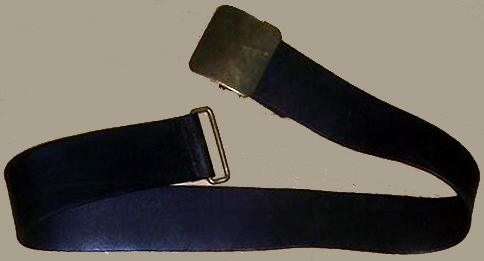
Model 1903
The M1903 was intended to replace the M1845 as the standard issue belt. But there was a strong reticence to abandon the much flashier M1845 buckle. Consequently, the M1903 existed in only limited quantities at the start of the war with only a small number of regiments receiving them before being mustered into service. The belt would see only limited service in winter of 1914-1915 before being supplanted by the M1903/14. Like its predecessor, the M1903 was 55 mm wide and was made of blackened (flesh side only) leather with the flesh side facing out. Of significance, for fastening it featured a brass roller buckle with a sharp angled rectangular frame and two prongs. On the buckle end, the belt was sewn closed with three parallel lines of stitches. Attached close to the buckle was a fixed belt loop, with an added mobile keeper meant to receive any excess length. The number of holes did not vary with 11 pairs of holes (22 holes in total) per regulations independent of the length of the belt, which was made in three sizes: 110, 115 and 125 cm.

Model 1903/14
The regulation of 9 December 1914, which redefined the uniforms of the French army on a whole, adopted that from then on, all French leather gear would no longer be blackened but would be left in its natural tan color called ‘fauve’. Additionally, all leather items were now made with the smooth grain side facing out. The first M1903/14s were distributed to new recruits and returning wounded before joining their front-line units beginning in the spring of 1915. Gradually the new belts were distributed to all front-line troops, replacing the black leather items. The width of the M1903/14 belt remained unchanged from its predecessor at 55 mm, and likewise came in three lengths: 110, 115 and 125 cm. Per regulations, the number of holes remained the same: 11 pairs of holes (22 in total). The buckle assembly also remained the same as the 1903, a brass two-pronged roller buckle, with the exception that the buckle frame now had rounded corners. As a matter of economy, later versions of the M1903/14 were made with japanned (black lacquered) buckle assemblies as well, though it is believed this version was widely distributed.

War-Time Models
To economize material and labor, war-time versions of the M1903 and M1903/14 belts began to appear in the fall of 1914 and would remain in use throughout the war. Primarily these can be identified by the use of rivets (brass or japanned iron) in combination with or in complete replacement of stitching. Single-prong buckles were also made in lesser quantities, both in brass and japanned iron.
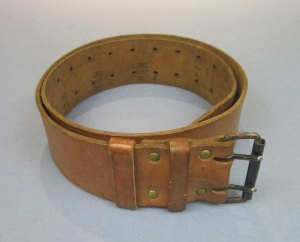
Ersatz Models
Right from the first weeks of the war, the obsolete form of the regulation belt is glaringly obvious. Of particular concern is the conspicuous appearance of the French soldier’s kit, including the brass buckles on the M1845 belts. While army commanders preferred to see production of the M1903 belt ramped up, there is a significant shortfall of equipment on-hand at the end of 1914 and into 1915. In the gap, various ersatz models of equipment begin to come out of factories and military depots alike. M1845 belts made of canvas and cotton webbing in various neutral shades are made with the plate buckle in either the normal brass or in iron, the latter normally blackened. And in January 1915, a process is put in place of blackening any brass buckles still in service among front-line units. Despite this, as late as the end of 1915 some examples exist of soldiers still wearing the regulation belts issued at mobilization and unmodified. As with the M1845, ersatz versions of the M1903 and M1903/14 made in canvas and cotton webbing were produced in the face of the material shortages. Likewise, buckle assemblies featuring only a single-prong, in brass as well as in iron, were also seen. As with much of the makeshift equipment that was seen in 1915, the front-line units were given precedence and normally received the regulation models, while most of the ersatz belts were panned off on new recruits while training in the depots and to territorial units generally.
le Bretelles de Suspension ("Suspenders")
Model 1892
Beginning in 1892, a change was put into effect for the method in which leather accoutrements were worn with the introduction of suspenders. These were intended to attach to and support the three cartridge pouches each soldier wore. As noted before, the M1892 suspenders like other French leather equipment of the period were made with the flesh side facing out and blackened on the flesh side only. The system consisted of two frontal straps and one shorter strap in the rear joined by an iron ring, the whole taking the form of a ‘Y’. (A common phrase among English-speakers is to refer to these as Y-straps as a result, though this term was never used by the French army). Each strap was punched with 9 holes (generally 5 mm apart) to allow for height adjustment, which received the M1845 j-shaped hooks made in brass. Any excess length could be folded back on itself to the inside and fixed in place using the hook, though some soldiers simply cut off the excess despite regulations forbidding the practice. The strap ends that attached to the ring meanwhile were entirely sewn in place with a parallel line of stitches (i.e. no reinforcement rivets). Some examples do exist with rivets added after production for repair purposes.
Model 1892/14
As noted, the regulation of 9 December 1914 stipulated that from then on all French leather gear would no longer be blackened, instead being left in its natural tan color called ‘fauve’ and with the grain side facing out. Aside from this change, the regulation suspenders remained unchanged in form for the rest of the war, including leaving the number of punched holes at 9. Like the new belts, the first M1892/14s were distributed to new recruits and returning wounded before joining their front-line units beginning in the spring of 1915. This explains one of the alternate nicknames given to new soldiers -- Curroies Jaunes or "Yellow Straps" -- in reference to the color of the new leather gear they wore. Gradually the new suspenders were distributed to all front-line troops, replacing the black leather items, though the old suspenders would continue to be issued to new recruits in training depots before being sent to the front, as well as to territorial units to a lesser extent. One other minor modification to the suspenders came with the introduction of hooks that resembled a lower case "d" (the shape was intended to counteract the habit of the hooks becoming undone from the cartridge pouches) made in either brass or japanned iron. Due to the weakness of the seams where the straps joined the dorsal ring, rivets would begin to be added to the Model 1892/14 suspenders at production, though entirely sewn versions continued to be made until the end of the war.
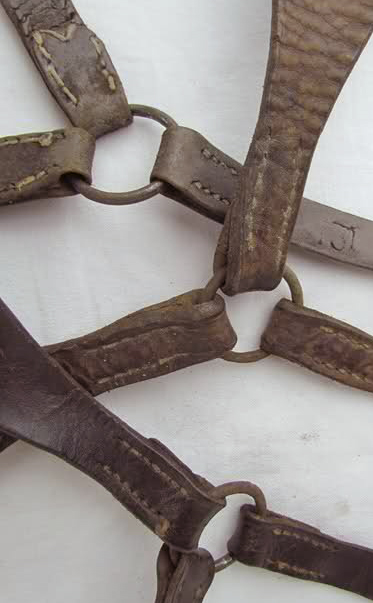
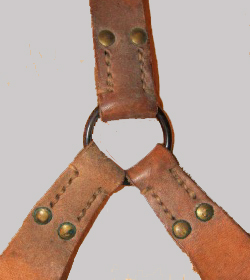
War-Time Models
As noted, some manufacturers begin to add rivets as reinforcements where the straps joined the dorsal ring, either two side by side and below the stitch lines or one single rivet in between the stitch lines. Examples also exist of entirely riveted versions as well that featured two rivets side by side or three rivets in a triangle. As a matter of economy, some manufacturers made suspenders that were entirely riveted (brass and japanned metal). All of these could be described as war-time versions.
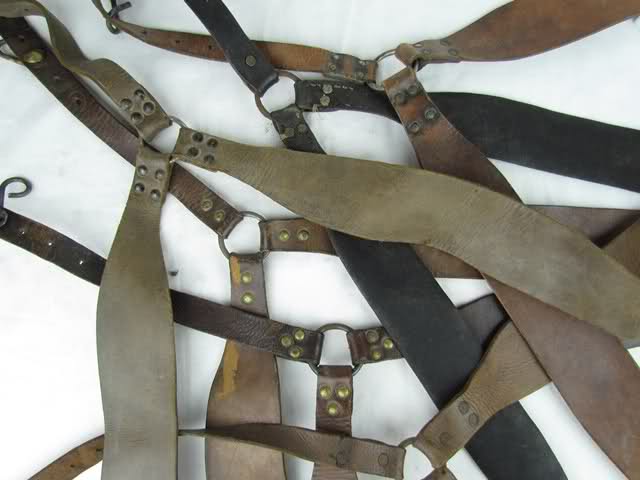

Ersatz Models
As with the belts, the shortfall of material first encountered at the end of 1914 saw the manufacture of suspenders in various types of canvas and cotton webbing and varying colors. Normally riveted holes of varying number were punched into the cloth to allow for height adjustment. A special note on distinguishing WWI-era suspenders from those made post-1945: The suspenders made post 1945 normally have 11 holes punched down the lengths, are generally more of a pale flesh color when new, and almost exclusively feature two parallel lines of stitching and two rivets on the end connected to the dorsal ring.
les Cartouchières ("Cartridge Pouches")
Model 1888
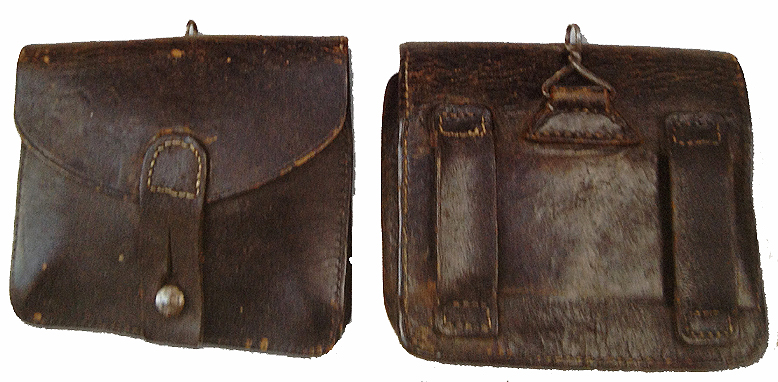
In 1886 the Lebel rifle became the regulation arm of the infantry and with its distribution a new cartridge pouch was needed to carry the 8 mm cartridge. The M1888 was one of the primary cartridge pouches distributed at the time of mobilization. It was modeled after the M1869 though with a reduced size. It was composed of three principal pieces: a front, a back which also formed the front flap, and a gusset that fastened the flap closed. On the back were sewn two vertical belt loops and a small triangular leather tab which received the tin suspension triangle. On the front side of the pouch, a closure gusset was sewn to the flap which fastened onto a flat-headed tinned metal finial (1 cm in diameter, 1 cm high) via a simple button hole. The interior rivet of the finial was covered over with a small round leather tab in order to avoid having the rivet rub against the cartridge packets. The pouch was made with blackened leather (grain side only) with the grain side facing out. Each pouch could hold up to 5 packets of 8 cartridges.
Model 1905
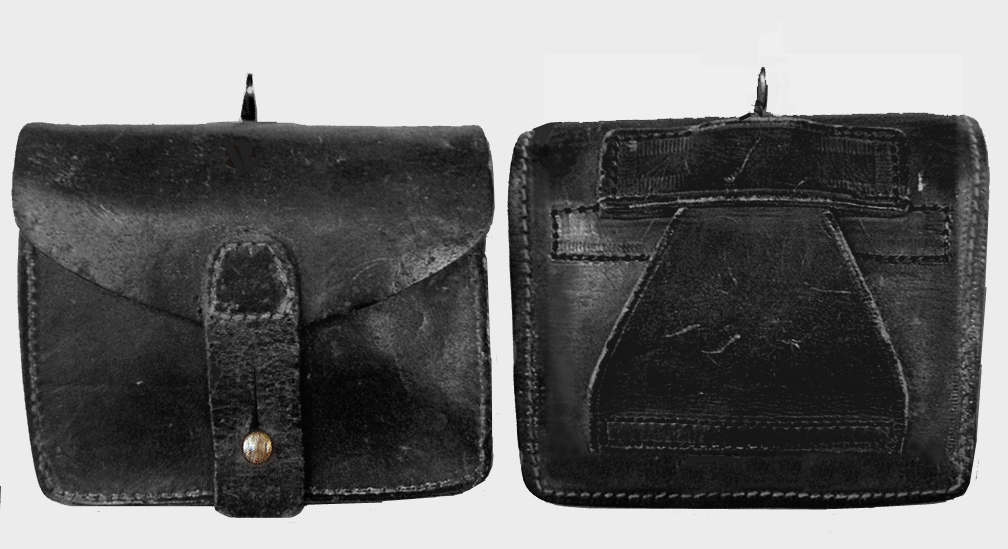
In 1905, in a modest attempt to modify the antiquated leather gear, a modification is made to the cartridge pouch to permit it to be unfastened from the belt without having to unbuckle the belt. The two rear vertical belt loops along with the leather tab that held the metal suspension triangle are replaced with a large vertical trapezoidal-shaped belt loop, the top of which received the suspension triangle. The top of this belt loop and the suspension triangle was inserted in to a horizontal loop mounted near the top of the back of the pouch. However, a flaw in the design quickly comes to light. When the pouch was loaded with rounds, the suspension triangle tended to come unhooked from the suspender hooks and then slipped under the rear horizontal loop and the pouch itself. To remedy this problem, the end of the suspender hook was twisted 90 degrees and the hook resembled a lower case "d". This modified hardware had not fully been distributed before the outbreak of war and many suspenders were equipped with the old j-hooks. A second modification made with the adoption of the M1905 pouch was the addition of an internal flap sewn to the back of pouch, which was intended to keep cartridges from falling out when the flap was open. Though, due to its position, this internal flap did not in fact serve its purpose well and a modification would have to be made in the next version to solve the problem. Along with the M1888, the M1905 would be the most widely distributed cartridge pouch at the start of the war.
Model 1888/14 and 1905/14
The regulation of December 1914 stipulating that leather equipment be issued in its natural tan color equally applied to cartridge pouches. The new model identical in design to the existing M1888 and M1905 is put into production and denominated as the M1888/14 and M1905/14, respectively. The only other change is the gradual replacement of the flat-headed finial with a round-headed, bulbous version (of roughly identical dimensions) made of either tinned metal or brass (though stocks of flat-headed versions were still used for a time as well). Before the new tan leathers could fully replace the black leathers though, existing stocks of the latter first had to be exhausted. To the extent possible, the M1888/14 and M1905/14 pouches were distributed to new recruits and returning wounded before joining their front-line units beginning in the spring of 1915. Gradually the new pouches were distributed to all front-line troops, replacing the black leathers. Like the black suspenders though, the black pouches would continue to be issued to new recruits in training depots before being sent to the front, as well as to territorial units to a lesser extent.
Model 1916
In 1916 a new model of cartridge pouch was adopted which corrected the flaws that appeared with the M1905. The trapezoidal belt loop was lengthened by about 20 mm and the end of the vertical belt loop that held the suspension triangle is folded back to the outside and a small inner layer tab of leather is added inside of this in order to increase the thickness. This keeps the suspension triangle from slipping under the rear horizontal loop. Additionally, the internal flap intended to keep cartridges from falling out of the pouch was moved and sewn to the front of the pouch, thus orienting it to the rear. A notch is cut into the middle of this flap in order to better allow the soldier’s fingers into the pouch when retrieving a cartridge. The finial used in the M1916 remains the round-headed version made of tinned metal but more generally of brass. The interior small round leather tab covering the rivet of the finial was suppressed. While production of M1916 was quickly ramped up, existing stocks of older molders had to be subsumed first, so that the M1916 would only begin seeing wide distribution starting in 1917.
Other Pre-War Models
Since the adoption of the Gras rifle in 1874, no less than three different models of cartridge pouches were put into service in a period of less than 10 years. These models -- 1877, 1882 and 1884 -- are more rightly referred to as “rigid box” models. Without sufficient stocks of the M1888 and M1905 pouches, at the start of the war some units were issued with these antiquated models, particularly the older reservists and territorials. In a modest attempt to standardize the method of wearing the pouches, some M1877, M1882 and M1884s had the triangular leather tabs holding the suspension triangles (per the M1888 design) sewn onto the backs so that they could receive the suspender hooks.
War-Time Models
As with other leather gear, economized cartridge pouches were made in the first urgent months of the war which utilized either a combination of sewn seams and rivets (brass or iron) or all rivets. M1905 and M1905/14s alike were produced using a variety of rivet sizes and layouts. Both flat and round-headed finials were used in these economized versions.
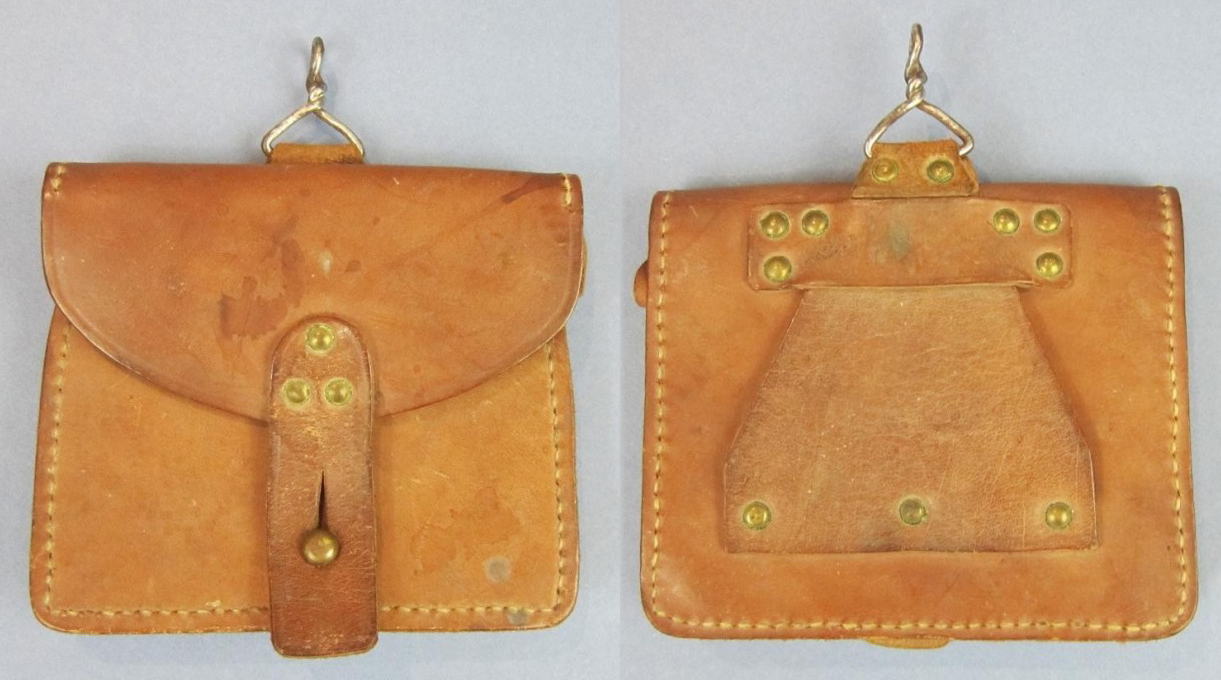
Ersatz Models
Ersatz models of cartridge pouches began appearing as early as the end of 1914. The quality and style of these varied greatly and reflect the great urgency of equipping troops in the shortfall of stocks, especially in the first months of 1915. These innumerable ersatz models were made of various types of canvas, with fastening gussets and belt loops made alternately of canvas or leather, and various types of finials, buttons or snaps for closing. Some followed closely the regulation design while others verged wildly from them. Once again though, by and large troops in front-line units did not receive these makeshift pouches, which were mostly handed off to new recruits in training, territorials and other rear-echelon formations.
la Porte-Baïonette ("Bayonet Carrier")
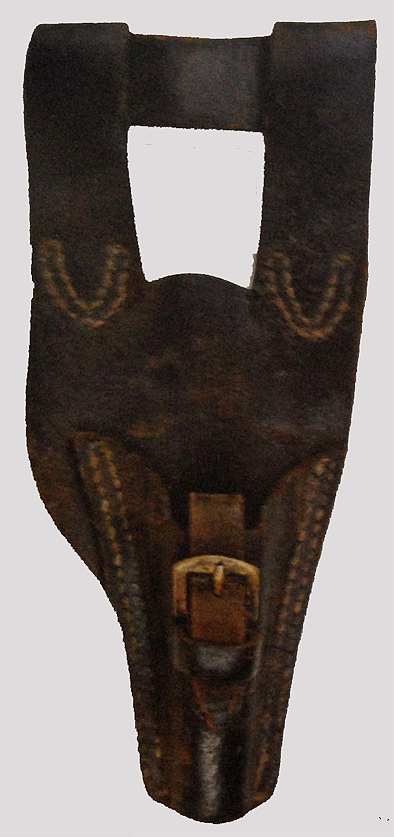 Model 1888
Model 1888Like other leather accoutrements of the French army, the bayonet carrier (or frog, as it is often known) had changed very little in design in the decades before the Great War. The frog for the M1886 épée-bayonet was similar to that made for the Gras sabre-bayonet and was exceedingly simple in design. Like its predecessor the M1888 frog featured a small strap that fed through the corresponding strap loop on the scabbard which secured it to the frog, as well as the two parallel belt loops that allowed for the cloth belt loop on the greatcoat to fit between them. The M1888 was blackened on the flesh side only, with the flesh side of the leather facing out. The small buckle that adorned the frog was made of brass. The frog was entirely sewn, with no reinforcement rivets.
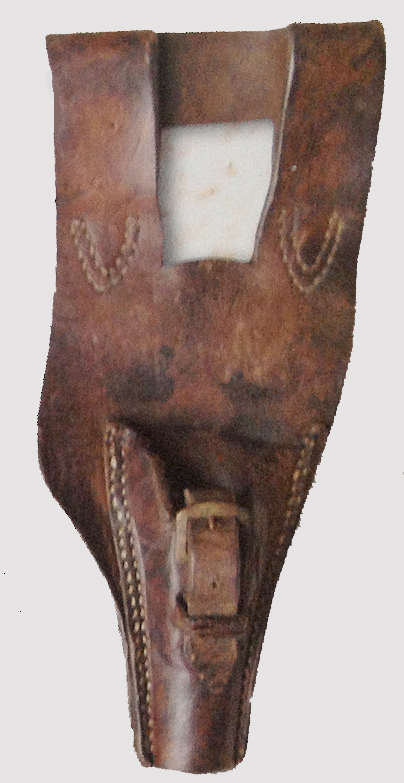
Model 1888/14
As with the other leather accoutrements, in December 1914 the M1888 frog began to be produced in its natural tan and with the grain side facing out. Otherwise, no other modifications were made. Like it's predecessor, the regulation M1888/14 was also entirely sewn with no incorporation of rivets. The buckle was made both in brass and blackened metal.
War-Time Models
An economized M1888/14 was also made during the war which relied entirely on rivets for joining the seams. These were either brass or japanned iron. Likewise, japanned iron buckles were also put to use.
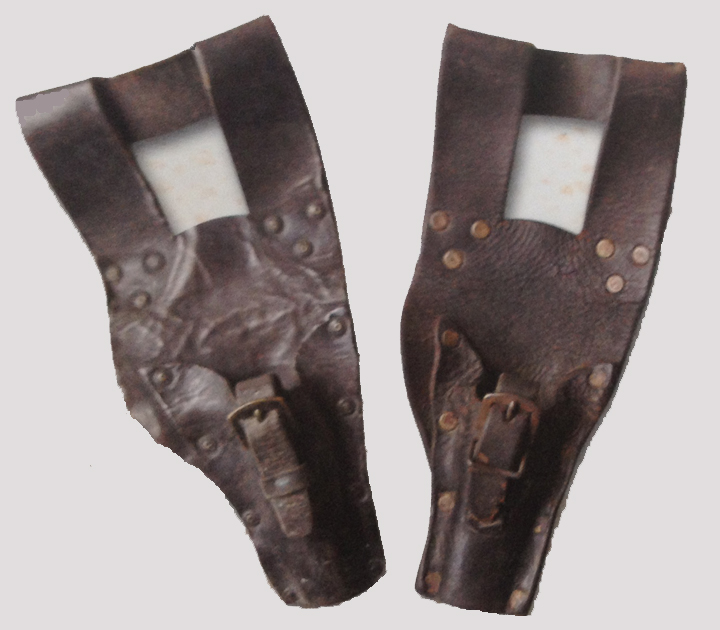
Ersatz Models
Again, ersatz versions of the frog sprung up in the first months of 1915, many of which were dubious in quality. Most were made of cotton canvas of what type or another and in various colors.





